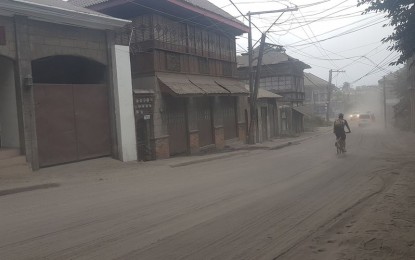
BEYOND THE ASHES. Ash spewed by Taal Volcano's eruption blanket the main road of Taal town in Batangas on Monday (Jan. 13, 2020). Classified as a third-class municipality, the town is a home of many past and present-day heroes of the country. (PNA photo by Benjamin Pulta)
MANILA -- From the word itself which means true, genuine and pure in the local Batangueño dialect, the start of a new decade spelled real disaster for the town of Taal with the eruption of the volcano to which it shares its name with.
Beyond the faces of people and places covered with thick ash, the volcano's eruptions have shaped the geography and the temperament of the town.
Based on historical accounts, Taal has moved away from its original location near the lake after the 17th-century explosion of the volcano to its present location on higher ground.
The original site of Taal town near the Taal Lake eventually became the town of San Nicolas. The upper portion of the original basilica put up by the Augustinians can still be seen in the old site before the latest eruption.
On Jan. 12, the streets of the town were filled anew with ash as the volcano threatened to destroy its nearly forgotten place in history.
A town of heroes
Aside from being the home of the Minor Basilica of Saint Martin of Tours, Asia's largest Catholic church, the town was the birthplace of most ilustrado (middle class) revolutionaries of the 19th century.
At present, the National Museum for Fine Arts in Manila houses a number of portraits done by the 19th-century Filipino artists, including that of a dignified gaunt gentleman in European clothes.
The gentleman in the painting by Felix Hidalgo is Felipe Agoncillo, a Filipino lawyer and revolutionary who represented the Philippine revolutionary government in the Treaty of Paris where the islands were sold by colonial Spain to the United States.
In exile in Hong Kong along with other revolutionaries, Agoncillo spoke eloquently about the country and its people to all westerners who would listen in an effort to change their minds that an educated population with a functional society existed in the islands contrary to the then prevailing western perception of islands filled with savages who were the white man's burden to civilize.
Agoncillo's wife Marcella would be asked by the revolutionaries led by Emilio Aguinaldo to sew for them the Philippine flag while they were in exile in Hong Kong. The flag was later used by Filipino forces.
On the main road of the town of Taal exists the mansions where Agoncillo was born and the house he lived with Marcela and their daughters.
The couple's daughters did not marry and the house was later donated to the government and is now one of four museums in Taal.
The Agoncillos are just two of the revolutionary heroes from Taal and who lived practically a stone's throw from each other.
A few meters from the house of Don Gregorio Agoncillo is the ancestral home of a family of bankers, the Alcasids led by its patriarch, lawyer and former Philippine National Oil Company (PNOC) chief executive officer, Herminio Alcasid Sr., the father of celebrity songwriter Ogie.
Two mansions facing each other near the main road are particularly notable being the twin homes of Eulalio and Gliceria Villavicencio and Juan Goco's family. Gliceria was a driving force of the revolution as a financier of the purchase of arms and materiel including helping in funding the publication of Jose P. Rizal's Noli Me Tangere.
The Villavicencio descendants presently run hotels, the Triple V restaurants, and the Flying V gasoline stations.
Goco was the treasurer of the revolutionaries and the forefather of the late solicitor general Raul Goco and restaurateur Roby Goco.
Andres Bonifacio, supposedly roamed along the Pansipit River under the guise of being a cockfighter to meet with Gliceria to secure funding for the Filipino forces to continue its fight.
Gliceria also lent funds for the purchase of the revolutionary forces' first naval battleship, the Bulusan. This seagoing revolutionary unit, called the Batalyong Maluya, was led by another Taal neighbor of Gliceria, Ananias Diokno. Diokno brought the war against the Spaniards to as far away as Iloilo and Central Visayas.
The Dioknos' ancestral house is at the edge of Taal's main road leading to Lemery town.
Ananias Diokno's descendants include former National Heritage Commission of the Philippines chair Serena Diokno, lawyer Jose Manuel Diokno and Bangko Sentral ng Pilipinas Governor Benjamin Diokno. The late Makati Judge Roberto Diokno was mayor of the adjacent town of San Luis and is best remembered for convicting Romeo Jalosjos in the 1990s.
Further down the street is the Ylagan-Barrion-Innumerable ancestral home.
Businessman Manny Innumerable, a keen photography enthusiast runs a camera museum which was so extensive that when Leica first chose to officially open a business in the Philippines, it borrowed priceless specimens of Barnack models from Innumerable to exhibit.
The family also owns Stage Riggers Inc. whose projects included arrangements for the Southeast Asian games, as well as most foreign artists' concerts in the country.
Maria Ylagan Orosa, a World War II hero, nurse and nutritionist was also born in Taal.
On the same road are the homes of the Garcias, Zagalas and Orlina families. Members of these families include lawyer Ma. Victoria Garcia, the wife of former senator Teofisto "TG" Guingona IV; the late Philippine Army (PA) commanding general (1972-1975) Gen. Romeo Zagala, father of Army public affairs office chief, Lt. Col. Ramon Zagala, and prominent glass Artist Ramon Orlina.
Volcanic ash may have blanketed anew the town's streets and corners but it can never cover the town as a narrative of excellence and its contribution to the country's history. (PNA)
